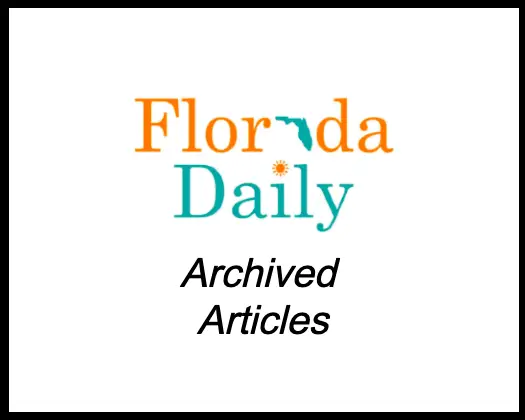On Wednesday, the Florida Trust for Historic Preservation announced this year’s “11 to Save,” a list of the most threatened historic properties in the state, at the Preservation on Main Street Annual Conference in collaboration with Florida Main Street.
This year’s list represents endangered historic resources in Duval, Escambia, Lake, Manatee, Miami-Dade, Orange, Osceola and Sarasota Counties, covering hundreds of years of history and a variety of cultural resources.
Each year, the Florida Trust for Historic Preservation announces its 11 to Save program as part of its conference. The program is designed to increase the public’s awareness of the urgent need to save Florida’s historic resources, and to empower local preservationists and preservation groups in their efforts to preserve Florida’s rich history.
“Each year, we receive more and more nominations from people around the state for the 11 to Save program,” said Florida Trust for Historic Preservation Board President Friederike Mittner. “This year’s list does a good job serving our goal to have the list reflect historic places that resonate with the people of Florida, to learn from and share the stories of these special places – and work with communities to make sure they are still here in years to come.”
Inclusion on the Florida’s 11 to Save is a starting point for the Florida Trust’s advocacy and education efforts, and is intended to be part of a collaborative effort to identify custom solutions for each property. Listings are not in any order of importance.
1. Black Bottom House of Prayer
Orlando (Orange County)
Built 1925
Built in 1925, the Black Bottom House of Prayer is a reminder of the once thriving and bustling Parramore community near Downtown Orlando. Located in a low lying section of the African-American neighborhood, the area was called Black Bottom, due to the black mud left from constant flooding. The Spanish Mission style building was originally occupied by the Pleasant Hill Colored Methodist Episcopal Church, which later became the Carter Tabernacle Christian Methodist Episcopal Church. One member recalled the women of the church holding lanterns for the men working on the church construction in the dark after their day’s work on their regular jobs.
One of the oldest African-American churches in Orlando, for nearly a century it has served as a religious entity, community meeting center and a school for the local African-American community. In the spring of 2020, the building was designated as an Orlando Historic Landmark. However, a recent roof collapse is endangering efforts to preserve the structure.
The Orange Preservation Trust and the National ADHD Foundation are in the process to secure resources to restore the historic landmark. The nominator hopes inclusion on this year’s 11 to Save list will help draw attention to on-going fundraising efforts for restoration and preservation.
2. Community of Cosmo and the Gullah Geechee Cultural Heritage Corridor
Jacksonville (Duval County)
Established ca. 1870s
The community of Cosmo was established in the late 1870s as a Gullah Geechee freedmen’s settlement community. The Gullah Geechee people are the descendants of West and Central Africans who were enslaved on coastal rice, indigo and Sea Island cotton plantations in North Carolina, South Carolina, Georgia and Florida. The nature of their enslavement on isolated island and coastal plantations created a unique culture with deep African retentions that are clearly visible in Gullah Geechee people’s distinctive arts, crafts, foodways, music and the Gullah language. An important part of Jacksonville’s Gullah Geechee history, Cosmo is still home to the descendants of the founders and retains historic buildings, burial grounds and fishing grounds on the banks of the St. Johns River.
Development in the area threatens significant historic and cultural resources, some of which lack local, state and federal historic designations that would provide important protection and generate resources for preservation. This is exacerbated by a lack of awareness among public officials and the general public about the historic significance of the community or the Gullah Geechee people.
The nominator seeks to raise awareness among public officials and the general public about the historic significance of Cosmo and other endangered Gullah Geechee settlements throughout Florida to engender support for additional resources for a range of historic and cultural preservation initiatives for these communities.
3. Downtown Jacksonville National Register Historic District (pictured above)
Jacksonville (Duval County)
Designated 2016
In May 2016, 56 blocks of Downtown Jacksonville were listed in the National Register of Historic Places as a historic district. This 158-acre historic district contains a contiguous group of resources that relate to the development of Florida’s first big city central business district as a commercial, institutional, and residential hub following the Great Fire of 1901.
Despite inclusion on the National Register, many prominent historic and culturally significant sites including the City Hall Annex, Greyhound Bus Station, First Baptist Church Sunday School Building and the Universal Marion (JEA) Building, have been razed, approved for demolition and/or have a future in doubt today. As a result, various community groups and organizations such as the Mapping Jax Group are rallying public officials to modify local preservation and adaptive reuse policies to encourage rehabilitation and local landmarking of what is left.
Acknowledging local policies and programs aimed at rehabilitating historic buildings have not done enough, the Downtown Investment Authority has proposed a plan to revise historic preservation and revitalization trust fund guidelines, recommend that the city council adopt a new program to incentivize rehabilitation of historic landmarks as well as target code compliance improvements to landmarks and non-landmarked older buildings. In the upcoming months, it will be up to City Council to decide if the proposed program is ultimately adopted.
4. Eatonville Historic District
Eatonville (Orange County)
Established 1887
A Florida Main Street community, Eatonville is historically significant for being one of the first self-governing all-Black municipalities in the United States. The town was named after Josiah C. Eaton, one of a small group of white landowners who were willing to sell sufficient land to African Americans to incorporate as a Black town on August 15, 1887.
Containing 48 historic buildings at the time, the Eatonville Historic District was designated and added to the National Register of Historic Places on February 3, 1998. Many of its properties are related to its most famous former resident, Zora Neale Hurston. Hurston was a noted writer, folklorist, and anthropologist associated with the Harlem Renaissance.
Club Eaton, another property, was a popular stop on the Chitlin’ Circuit, hosting performers ranging from Ray Charles, Ella Fitzgerald and Billie Holiday to James Brown, B.B. King and Aretha Franklin. The district’s oldest property, the Thomas House, was built in 1881 as the town’s first church, also eventually becoming the town’s first library. Today, many structures within the historic district, including Club Eaton and the Thomas House, are threatened by neglect.
5. Lee School
Leesburg (Lake County)
Built 1915
Built in 1915, Lee School, later known as the Lee Adult Education Center, is an historic school in Leesburg that was added to the National Register of Historic Places in 1995. During World War II, the school served as a community center and daycare center of the children of mothers working during the war effort. As a school, the structure has served as a place of education for approximately seven generations of Leesburg residents.
Currently the rapidly deteriorating property is in danger of being demolished to make room for a senior living development. Original redevelopment plans in 2014 called for the school being restored into a 152-unit assisted living and senior independent living development. Sold again in 2018, the new property owner requested permission to raze the historic structure with the explanation that the building was in worse shape than originally expected.
Local nonprofit art and cultural organization, Leesburg Center for the Arts is working with the City of Leesburg Building and Planning department to save the buildings, renovate and reuse as a studio space and arts education center for artists, and creatives, as well as a children’s and history museum.
6. McFarlane Historic District
Coral Gables (Miami-Dade County)
Established 1925
The MacFarlane Historic District is a Black community nationally designated on the National Register of Historic Places. In 1925, Flora MacFarlane, the area’s first solo female homesteader and schoolteacher, sold the twenty acres that today constitute the historic district to Coral Gables founder George Merrick’s company, which developed the property into a subdivision. Many Bahamian immigrant laborers, particularly Afro-Bahamians, subsequently built residences there. Originally, 32 homes made up the MacFarlane Homestead Historic District when it was designated in 1994 on the National Register with areas of significance including Ethnic Heritage, Community Planning and Development and Architecture between 1925 and 1949.
A rare example of a Black community in Florida to designated as a National Register of Historic Places Historic District, the community is threatened due to on-going redevelopment in the area and homes that have been lost to neglect.
7. Pensacola Vocational School
Pensacola (Escambia County)
Built 1942
With the Second World War looming, the Pensacola Vocational School (also known as the Pensacola Trade School) was completed in 1942 by the Works Progress Administration. During World War II, the school trained both civilian and military students, including Pensacola’s own “Rosie the Riveter” women who took up jobs previously occupied by men. The school also later trained Black students, and during its later tenure, served as the administrative headquarters of the Escambia County School District. In addition, the building was named in honor of Dr. Vernon McDaniel, the county’s first Black school board member.
Along with its historic and cultural significance, the Vocational School Building is one of the few pre-1950 buildings remaining in the city’s Tanyard neighborhood. One of Pensacola’s oldest neighborhoods, the racially diverse Tanyard community developed adjacent to the city’s working waterfront during the late 19th century. Since the 1970s, Tanyard has been decimated by urban renewal, gentrification and ongoing redevelopment.
Vacant since 2010, the John Sunday Society named the Pensacola Vocational School to its 2019 Seven to Save list and has encouraged the owner to incorporate the building into redevelopment plans. Inclusion of the school building into the site’s proposed redevelopment could help bolster efforts to save other remaining historic structures in the neighborhood.
8. S.H. Johnson X-Ray Clinic
Miami (Miami-Dade County)
Built 1939
Built in 1939, the S.H. Johnson X-Ray Clinic reflects the reality of segregated life in Miami during the early decades of the 20th century. An example of Streamline Moderne architecture, which was popular during the 1930s, the X-Ray Clinic is significant for its association with a prominent physician in Miami’s early Black community.
Dr. Samuel H. Johnson came to Miami as a child in 1903 and began to practice medicine in 1931. He later studied radiology and was the first Black physician in South Florida to establish a radiological practice. The clinic is an example and representation of the Jim Crow era as he built the practice because Blacks were not allowed to be x-rayed at the City Hospital. Dr. Johnson is said to have amassed the most extensive x-ray equipment of any Black practitioner in the country.
The X-Ray clinic has been vacant since 1972 and was in a deteriorated condition when it was donated to the Black Archives in 1981. Currently, the clinic is in desperate need of funding to restore to its original grandeur and bring it up to code.
9. Patten House
Ellenton (Manatee County)
Built 1895
The Patten House was built in 1895 by Dudley Patten, the son of General George Patten, who purchased the Gamble Plantation and moved his family from Savannah following the Civil War. Originally a one story, wooden structure, the House was expanded to include a second story, wrap around porch and an early indoor toilet. For 99 years, the local chapter of the United Daughters of the Confederacy has cared for the interior of the building and opened it to the public. The State of Florida is responsible for exterior maintenance.
Termite and other damage resulted in Patten House being closed in 2014. The nominator is seeking creative solutions for preserving and interpreting the building.
10. St. Cloud Municipal Utilities
St. Cloud (Osceola County)
Built 1926
Built in 1926, the St. Cloud Municipal Utilities plant was the first to provide electricity to a city established in 1909 as a retirement community for Civil War union veterans nicknamed “The Friendly Soldier City.” Prior to being sold to the Orlando Utilities Commission in 1994, the electrical utility plant produced power from a mixture of diesel and natural gas to cover a 150 square mile area that extended into south Orange County.
In operation until 2008, the site was deemed to be contaminated during the 1990s. Current remediation strategies to the site include the potential demolition of the historic structure.
In response, St. Cloud Main Street has formed a subcommittee to investigate various opportunities to bring forward to the City Council so they see options and possible financial assistance in restoring the structure into a viable economic driver. The nominator seeks inclusion to the 11 to Save list as a tool to help bring increased awareness to local officials that there is a public contingent who would like to see the St. Cloud Municipal Utilities building preserved.
11. Walter Farley House
Venice (Sarasota County)
Built 1956
Built in 1956, the Walter Farley House was designed by famed Sarasota School Architect Ralph Twitchell, with an addition by Jack West. It was built as the home and studio of Walter Farley, the author of the Black Stallion series of books. Walter and his wife Rosemary were tightly integrated into Venice and its literary community. They were founding members of the Friends of the Venice Library. They also hosted gatherings in their home for members of the Ringling Brothers and Barnum & Bailey Circus.
Nestled on a couple of acres overlooking the Gulf of Mexico, the property is currently on the market and is dually listed as a home for sale (which is in need of repair) and as vacant land for a buyer to demolish in order to construct a new home. Included on the History & Preservation Coalition of Sarasota County’s 2020 Six to Save List, the nominator encourages local preservation groups and community leaders to collaborate and identify solutions for the preservation of the property.








